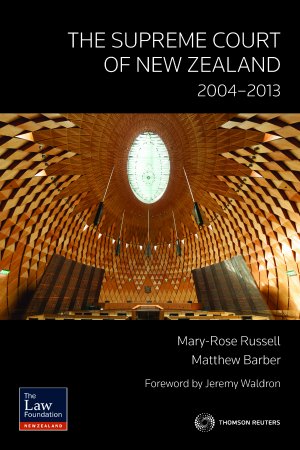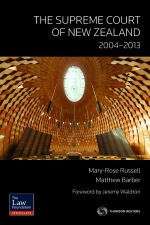The Supreme Court of New Zealand: its first 10 years
In 2004, as a result of the establishment of the Supreme Court of New Zealand, we severed our one remaining judicial link with our colonial past: the Privy Council.
In doing so we left the equivalent of the parental home to stand on our own two feet.
The responsibility for establishing the court was principally shouldered by its inaugural bench: six judges from the Court of Appeal appointed on seniority and merit.
Despite initial qualms, (that we did not have a pool of sufficiently well-qualified judges to call on, that appointments would be made based on political persuasion, that we were a small country and as a consequence there would be a lack of judicial independence …), the court got on with its task.
A decade of decisions; achievements and trends
 The book The Supreme Court of New Zealand 2004 – 2013 examines the achievements, trends and significant decisions of the Supreme Court’s first decade.
The book The Supreme Court of New Zealand 2004 – 2013 examines the achievements, trends and significant decisions of the Supreme Court’s first decade.
In this interview Co-Editor Mary-Rose Russell discusses who would want such an in-depth treatment of what superficially appears as a very slight passage of time and why, as well as the challenges the court faces.
The questions asked are headlined. Mary-Rose’s answers are below them.
Who would benefit from this book?
Mary-Rose:
There are several audiences within the legal community who will benefit: legal academics interested in following the development of New Zealand law, practitioners and legal historians.
Legal academics
The Supreme Court of New Zealand is very young and yet despite its youth, its decisions are changing our legal landscape, albeit slowly and carefully. (Where the court is now is comparable to its Canadian and Australian counterparts after a similar period of time.) Legal academics will want the book as it consolidates what has been a scattered and piecemeal approach to tracking the court’s influence legislatively and socially. To complement its comprehensive analysis, it brings together all 1202 cases heard by the court, making it a valuable, and time saving research resource.
Practitioners
Practitioners will want the text because it is the first detailed documentation of court’s activity and influence. What happens in the Supreme Court sets a precedent which will inevitably have a bearing on how cases are handled in the courts below it. The authoritative critical analysis and commentary by respected experts offers an overview of the developing jurisprudence citing the major cases in each of their subject areas.
Of particular interest are those areas that were historically under-represented in the Privy Council’s hearings for instance: criminal law.
We have seen areas within that (eg. Disorderly and Offensive Behaviour) where decisions, particularly Brooker v Police [2007] NZSC 30 and Valerie Morse v Police [2011] NZSC 45 have dramatically influenced how clients are advised.
Other topic areas covered include the Bill of Rights, contractual interpretation, a barrister’s perspective, company, torts, public, employment and tax law.
Legal historians
The book provides the first comprehensive empirical examination of the Court’s outputs in its first ten years and this provides a basis for future research into adjudication by apex courts. The wide- ranging chapters provide a time capsule of legal and social issues which were important in New Zealand during this period.
What challenges and changes has the Supreme Court faced?
Mary-Rose:
One of the most significant initial challenges was to establish how appointments to the bench were made. Seeking to block politically influenced decisions the decision was made to appoint judges on seniority and merit. To date, although there has been considerable criticism leveled at the system, principally due to the circumstances leading to the allegations of judicial misconduct and subsequent resignation of Judge Wilson in 2010, those questioning the independence and integrity of the court have had their fears set aside.
Accessibility
Another challenge is over the very thing that was most keenly sought after, and a reason behind establishing the court in the first place. We wanted more accessibility and we wanted a court that was available to the people it served, and in the country they lived in.
Historically the Privy Council accepted very few cases from New Zealand and the majority that did get a hearing were in corporate law or tax areas.
In bringing the court home and dismantling the obstacles in the way toward getting a hearing, the court has opened the door to appeal applications that would never have previously ever been considered, let alone dignified with processing.
While the right to appeal is a democratically protected, there is unfortunately no guarantee that it will be exercised responsibly. The court finds itself having deal with matters which are vexatious and in the scheme of things, trivial. There is concern that matters genuinely needing and deserving attention are pushed aside by a steady stream of appeals made by a few with an enhanced sense of entitlement and the money to indulge it.
Rising expenses
Also flagged for more thought is the increasing expense involved in making an appeal. There is justifiable concern that the response to rising costs could, in the long term, impact on the evolution of law. The absence of cases due to their expense denies the development of our jurisprudence.
For instance, it has been noted that more and more parties involved in commercial disputes are side-stepping into mediation for resolution. A similar pattern has been seen in the employment area, despite the fact that justice at this level is now more readily available than it ever was under the old Privy Council regime.
NZ is not alone in seeing its court based justice system bypassed. This trend toward arbitration and mediation is mirrored internationally. It’s an area Ross Grantham discusses in Chapter Four and is mentioned in the Foreword by Jeremy Waldron.
Do you have any final comments?
Mary-Rose:
What began as research covered in Chapter One “Empirical Analysis of Supreme Court Decisions” by Matthew Barber and I grew into a much larger and more valuable study of the role, current function and possible future developments of the Court’s place in the growth of New Zealand’s law. We are extremely grateful to our fellow contributors and to the NZ Law Foundation for supporting and sharing our wish to chronicle its first decade.
As Jeremy Waldron says in his Foreword the resulting text will be of interest to anyone wanting to know how apex courts operate.
For more information:
To see the full list of contributors and their chapters please click the link:
